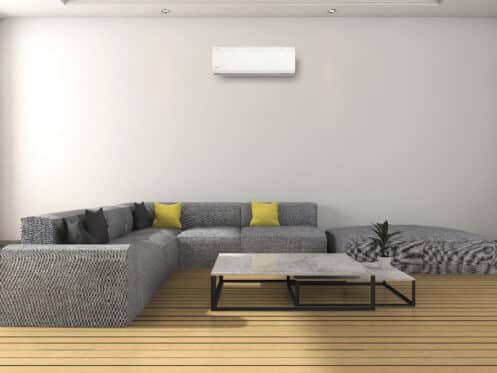When it comes to maintaining comfortable indoor temperatures, traditional HVAC systems often struggle to provide consistent comfort throughout a building. However, there’s a solution that offers both personalized comfort and energy efficiency: HVAC zoning systems. Keep reading to learn what HVAC zoning systems are, how they work, their advantages, different types, and considerations for implementing them in your home or business.
What Are HVAC Zoning Systems?
An HVAC zoning system is a sophisticated approach to heating, ventilation, and air conditioning that allows homeowners to control and regulate the temperature independently in different areas or zones of their living space. Unlike conventional HVAC setups that treat the entire home as a single unit, zoning systems divide the house into distinct zones, each equipped with its thermostat and damper controls. This granular level of control enables users to customize the comfort levels in each zone according to their specific needs and preferences, optimizing energy usage and overall comfort.
How They Work
The functioning of an HVAC zoning system relies on several key components. Firstly, multiple thermostats are placed strategically throughout the home, typically one for each zone. These thermostats continuously monitor the temperature in their respective zones and send signals to the main control panel. The central control panel acts as the system’s brain, receiving inputs from the thermostats and managing the operation of the HVAC equipment based on the information received.
In addition to the thermostats and control panel, HVAC zoning systems incorporate motorized dampers installed within the ductwork. These dampers act as gates, regulating the airflow to different zones. When a thermostat in a particular zone signals a need for heating or cooling, the control panel commands the corresponding damper to open or close, directing the conditioned air to that specific zone. This process ensures that only the required areas receive conditioned air, preventing energy wastage by heating or cooling unoccupied spaces.
To complement the zoning system, some models may include zone sensors that measure various environmental factors such as humidity, occupancy, or air quality. These sensors provide additional data to the control panel, allowing for even more precise and efficient temperature adjustments in each zone.
Advantages of HVAC Zoning Systems
Energy Efficiency
The system eliminates wasteful energy consumption in unoccupied zones by heating or cooling only the occupied areas. This targeted approach results in substantial energy savings, reducing utility bills, and a smaller carbon footprint.
Enhanced Comfort
HVAC zoning systems provide unparalleled comfort, allowing individualized temperature control in different zones. Occupants can set their preferred temperature in their specific areas, eliminating the discomfort of dealing with a uniform temperature throughout the building. Additionally, zoning prevents overheating or overcooling certain spaces, creating a more pleasant and customized indoor environment.
Cost Savings
The energy savings achieved through HVAC zoning systems translate into cost savings over time. While the initial installation costs may be higher compared to a traditional HVAC setup, the long-term benefits outweigh the upfront investment. Lower energy bills, reduced wear and tear on HVAC equipment, and potential maintenance savings contribute to the overall cost-effectiveness of the system.
Extended HVAC System Lifespan
HVAC zoning systems can prolong the life of the HVAC equipment by reducing its workload. By focusing heating and cooling efforts on specific zones, the system experiences less strain, reducing wear and tear. This can extend the lifespan of the HVAC components, saving money on premature replacements and increasing the system’s overall reliability.
Types of HVAC Zoning Systems
Single-Stage Zoning
Single-stage zoning systems offer basic zoning functionality and are suitable for smaller properties with straightforward heating and cooling needs. In this setup, the HVAC equipment operates at a single capacity level, and the zoning is limited to adjusting airflow to different zones. While cost-effective and relatively simple, single-stage zoning lacks the precision and customization of multi-stage systems.
Multi-Stage Zoning
Multi-stage zoning is a more advanced and sophisticated approach to HVAC zoning. This system offers precise control over HVAC equipment, allowing it to operate at different capacity levels based on each zone’s heating or cooling demands. Multi-stage zoning excels in larger properties with varying usage patterns, as it can adapt and fine-tune its operation to suit the specific requirements of each zone.
Wireless Zoning Systems
Wireless zoning systems utilize wireless communication between thermostats and the control panel, eliminating the need for complex wiring installations. This wireless setup offers greater flexibility in placing thermostats, making it an attractive option for retrofits or installations where extensive wiring may not be feasible. However, wireless systems may face challenges with signal interference and require stable network connectivity for seamless operation.
Contact Professionals Today!
Do you need top-notch heating, air conditioning, and water heater services in Huntingdon Valley and the surrounding areas? Look no further than AAA Brothers Heating & Air Conditioning! We are your trusted experts in all things HVAC and water heating. Whether it’s a repair, installation, or maintenance, our skilled technicians are ready to deliver efficient and reliable solutions for your home or business. Contact AAA Brothers Heating & Air Conditioning today for exceptional service.



